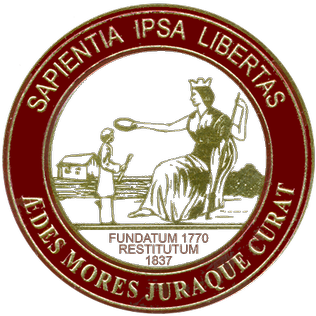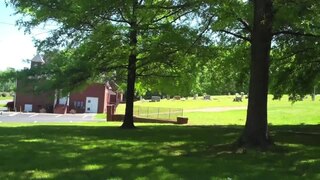
Seneca is a city in Oconee County, South Carolina, United States. The population was 8,102 at the 2010 census. It is the principal city of the Seneca Micropolitan Statistical Area, an (MSA) that includes all of Oconee County, and that is included within the greater Greenville-Spartanburg-Anderson, South Carolina Combined Statistical Area. Seneca was named for the nearby Cherokee town of Isunigu, which English colonists knew as "Seneca Town".

The College of Charleston is a public liberal arts college in Charleston, South Carolina. Founded in 1770 and chartered in 1785, it is the oldest college in South Carolina, the 13th oldest institution of higher learning in the United States, and the oldest municipal college in the country. The founders of the college include three future signers of the Declaration of Independence, and three future signers of the United States Constitution.

Wright Brothers National Memorial, located in Kill Devil Hills, North Carolina, commemorates the first successful, sustained, powered flights in a heavier-than-air machine. From 1900 to 1903, Wilbur and Orville Wright came here from Dayton, Ohio, based on information from the U.S. Weather Bureau about the area's steady winds. They also valued the privacy provided by this location, which in the early twentieth century was remote from major population centers.

Stagville Plantation is located in Durham County, North Carolina. With buildings constructed from the late 18th century to the mid-19th century, Stagville was part of one of the largest plantation complexes in the American South. The entire complex was owned by the Bennehan, Mantack and Cameron families; it comprised roughly 30,000 acres (120 km2) and was home to almost 900 enslaved African Americans in 1860.

The Rosenwald School project built more than 5,000 schools, shops, and teacher homes in the United States primarily for the education of African-American children in the South during the early 20th century. The project was the product of the partnership of Julius Rosenwald, a Jewish-American clothier who became part-owner and president of Sears, Roebuck, and Company and the African-American leader, educator, and philanthropist Booker T. Washington, who was president of the Tuskegee Institute.

Charles Morrison Robinson, most commonly known as Charles M. Robinson, was an American architect. He worked in Altoona and Pittsburgh, Pennsylvania from 1889 to 1906 and in Richmond, Virginia from 1906 until the time of his death in 1932. He is most remembered as a prolific designer of educational buildings in Virginia, including public schools in Richmond and throughout Virginia, and university buildings for James Madison University, College of William and Mary, Radford University, Virginia State University, University of Mary Washington, and the University of Richmond. He was also the public school architect of the Richmond Public Schools from 1910 to 1929. Many of his works have been listed on the National Register of Historic Places.

The T.G. Richards and Company Store, also known as Whatcom County Courthouse and James B. Steadman Post No. 24, is the first and oldest brick building in the state of Washington, United States, and is listed on the U.S. National Register of Historic Places.

Flora Macdonald College was a women's college in Red Springs, Robeson County, North Carolina. It was founded in 1896 by Dr. Charles Graves Vardell as the Red Springs Seminary, renamed Southern Presbyterian College and Conservatory of Music in 1903 then Flora Macdonald College in 1914.

This list includes properties and districts listed on the National Register of Historic Places in Wake County, North Carolina. Click the "Map of all coordinates" link to the right to view an online map of all properties and districts with latitude and longitude coordinates in the table below.

This list includes properties and districts listed on the National Register of Historic Places in Cumberland County, North Carolina, United States. Click the "Map of all coordinates" link to the right to view a Google map of all properties and districts with latitude and longitude coordinates in the table below.

The North Carolina School for the Deaf is a state-supported residential school for deaf children established in 1894, in Morganton, North Carolina, US.

Seaview Hospital was a historic tuberculosis sanatorium, now a national historic district located at Willowbrook on Staten Island, New York. The complex was planned and built between 1905 and 1938 and was the largest and most costly municipal facility for the treatment of tuberculosis of its date in the United States.

The Junior Order of United American Mechanics is an American fraternal order. It began as a youth affiliation of the Order of United American Mechanics, but seceded to become its own organization and eventually absorbed its parent order. Originally, it was an anti-Catholic, nativist group, but eventually abandoned this position and became a general fraternal benefit society open to people regardless of creed, race or sex.
Herbert B. Hunter was an architect in North Carolina. Early in his career he worked as a draughtsman for Leonard L. Hunter. His principal North Carolina projects occurring in the 1920s. Hunter established his own firm in High Point, North Carolina in the early 1920s. He was an early member of the North Carolina Chapter of the American Institute of Architects and was pictured among the group at the annual meeting in Charlotte in 1929. He worked as an architect for the National Park Service designing park buildings. President Franklin D. Roosevelt selected him to make the drawing for the White House Oval Room. He served in the U.S. Navy during World War I and World War II, planning hospitals and other structures.

The Central Children's Home of North Carolina, officially the Central Children's Home of North Carolina, Inc., and historically known as Grant Colored Asylum, was founded in Oxford, North Carolina, in 1883. The home is a residential group environment for children up to young adults.

Graylyn Estate, or Graylin, is a historic estate located in Winston-Salem, Forsyth County, North Carolina and was listed on the National Register of Historic Places in 1978. The construction of the Norman Revival style mansion began in 1928. Associated with the house are a number of contributing outbuildings including a garage-guest house and "farm" complex. Today, Graylyn estate is used as a conference center and hotel.

Murphey School is a historic school complex located near Hillsborough, Orange County, North Carolina. The Murphey School was built in 1923, and is a one-story, Spanish Revival style brick building with a hip-on-hip roof covered in pressed metal shingles resembling terra cotta tiles. The front facade features a projecting central hip roof front entrance. Attached to the school is a one-story neoclassical style auditorium addition built in 1936 with a Doric order portico. Also on the property is a contributing 1 1/2-story bungalow style teacherage, well house, and water tower.

J.C. Price High School, also known as the Joseph Charles Price High School, is a historic high school complex located at Salisbury, Rowan County, North Carolina. The school served as Salisbury's high school for African-American students from 1932 through the 1968–1969 school year. It was listed on the National Register of Historic Places in 2010.

Washington Magnet Elementary School is a historic school and building located at Raleigh, Wake County, North Carolina. It was built in 1923–1924 to serve African-American students in Raleigh and is now a magnet elementary school.





















